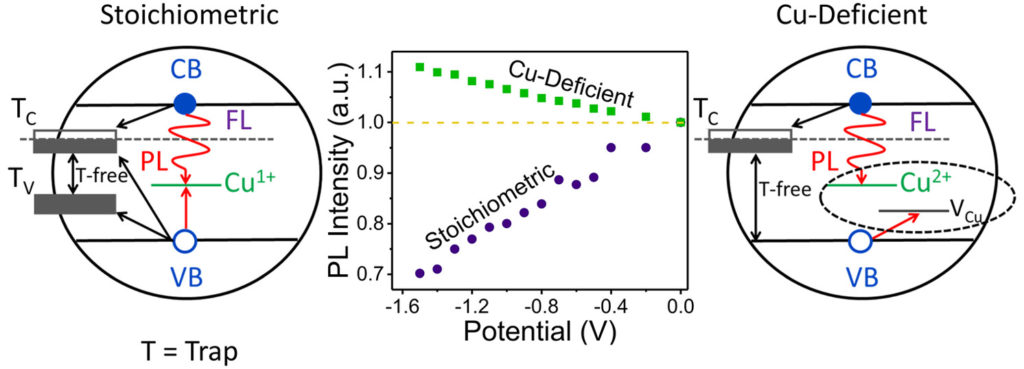
Luminescent CuInS2 (CIS) quantum dots (QDs) exhibit highly efficient intragap emission and long, hundreds-of-nanoseconds radiative lifetimes. These spectral properties, distinct from structurally similar II–VI QDs, can be explained by the involvement of intragap defect states containing a localized hole capable of coupling with a conduction band electron for a radiative transition. However, the absolute energies of the intragap and band-edge states, the structure of the emissive defect(s), and the role and origin of nonemissive decay channels still remain poorly understood. Here, we address these questions by applying methods of spectral electrochemistry. Cyclic voltammetry measurements reveal a well-defined intragap state whose redox potential is close to that of the Cux defect state (where x = 1+ or 2+). The energy offset of this state from the valence band accounts well for the apparent photoluminescence Stokes shift observed in optical spectra. These results provide direct evidence that Cu-related defects serve as emission centers responsible for strong intragap emission from CIS QDs. We then use in situ spectroelectrochemistry to reveal two distinct emission pathways based on the differing oxidation states of Cu defects, which can be controlled by altering QD stoichiometry (1+ for stoichiometric QDs and 2+ for Cu-deficient QDs).
Read the full article published in ACS Photonics here
 Luminescent CuInS2 (CIS) quantum dots (QDs) exhibit highly efficient intragap emission and long, hundreds-of-nanoseconds radiative lifetimes. These spectral properties, distinct from structurally similar II–VI QDs, can be explained by the involvement of intragap defect states containing a localized hole capable of coupling with a conduction band electron for a radiative transition. However, the absolute energies of the intragap and band-edge states, the structure of the emissive defect(s), and the role and origin of nonemissive decay channels still remain poorly understood. Here, we address these questions by applying methods of spectral electrochemistry. Cyclic voltammetry measurements reveal a well-defined intragap state whose redox potential is close to that of the Cux defect state (where x = 1+ or 2+). The energy offset of this state from the valence band accounts well for the apparent photoluminescence Stokes shift observed in optical spectra. These results provide direct evidence that Cu-related defects serve as emission centers responsible for strong intragap emission from CIS QDs. We then use in situ spectroelectrochemistry to reveal two distinct emission pathways based on the differing oxidation states of Cu defects, which can be controlled by altering QD stoichiometry (1+ for stoichiometric QDs and 2+ for Cu-deficient QDs).
Read the full article published in ACS Photonics here
Luminescent CuInS2 (CIS) quantum dots (QDs) exhibit highly efficient intragap emission and long, hundreds-of-nanoseconds radiative lifetimes. These spectral properties, distinct from structurally similar II–VI QDs, can be explained by the involvement of intragap defect states containing a localized hole capable of coupling with a conduction band electron for a radiative transition. However, the absolute energies of the intragap and band-edge states, the structure of the emissive defect(s), and the role and origin of nonemissive decay channels still remain poorly understood. Here, we address these questions by applying methods of spectral electrochemistry. Cyclic voltammetry measurements reveal a well-defined intragap state whose redox potential is close to that of the Cux defect state (where x = 1+ or 2+). The energy offset of this state from the valence band accounts well for the apparent photoluminescence Stokes shift observed in optical spectra. These results provide direct evidence that Cu-related defects serve as emission centers responsible for strong intragap emission from CIS QDs. We then use in situ spectroelectrochemistry to reveal two distinct emission pathways based on the differing oxidation states of Cu defects, which can be controlled by altering QD stoichiometry (1+ for stoichiometric QDs and 2+ for Cu-deficient QDs).
Read the full article published in ACS Photonics here






